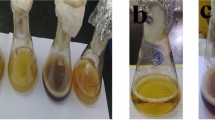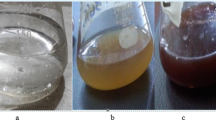Abstract
Sequential optimization strategy based on statistical experimental design and one-factor-at-a-time (OFAT) method were employed to optimize the process parameters for the enhancement of silver nanoparticles (AgNPs) production through biological synthesis using Pycnoporus sanguineus. Based on the OFAT method, three significant components influencing the size of AgNPs produced were identified as AgNO3 concentration, incubation temperature, and agitation speed. The optimum values of these process parameter for the synthesis of AgNPs were determined using response surface methodology (RSM) based on Box-Behnken design. The validity of the model developed was verified, and the statistical analysis showed that the optimum operating conditions were 0.001 M of AgNO3, 38°C, and 200 rpm with the smallest AgNPs produced at 14.86 nm. The disc diffusion method also suggested that AgNPs produced using optimum conditions have higher antimicrobial activity compared to the unoptimized AgNPs. The present study developed a robust operating condition for the production of AgNPs by P. sanguineus, which was 8.6-fold smaller than that obtained from un-optimized conditions.
Similar content being viewed by others
References
Ahmad A, Mukherjee P, Senapati S, Mandal D, Khan MI, Kumar R et al. (2003a) Extracellular biosynthesis of silver nanoparticles using the fungus Fusarium oxysporum. Colloids Surf B 28, 313–318.
Ahmad A, Senapati S, Khan MI, Kumar R, and Sastry M (2003b) Extracellular biosnythesis of monodisperse gold nanoparticles by a novel extremophilic actinomycete, Thermomonaspora sp. Langmuir 19, 3550–3553.
Al-Thabaiti SA, Al-Nowaiser FM, Obaid AY, Al-Youbi AO, and Khan Z (2008) Formation and characterization of surfactant stabilized silver nanoparticles: A kinetic study. Colloids Surf B 67, 230–237.
Anil Kumar S, Abyaneh MK, Gosavi SW, Kulkarni SK, Pasricha R, Ahmad A et al. (2007) Nitrate reductase-mediated synthesis of silver nanoparticles from AgNO3. Biotechnol Lett 29, 439–445.
Armenante PM and Nagamine EU (1998) Effect of low off-bottom impeller clearance on the minimum agitation speed for complete suspension of solids in stirred tanks. Chemical Eng Sci 53, 1757–1775.
Balaji D, Basavaraja S, Deshpande R, Mahesh D, Prabhakar B, and Venkataraman A (2009) Extracellular biosynthesis of functionalized silver nanoparticles by strains of Cladosporium cladosporioides fungus. Colloids Surf B 68, 88–92.
Beveridge TJ, Hughes MN, Lee H, Leung KT, Poole RK, Savvaidis I et al. (1996) Metal-Microbe Interactions: Contemporary Approaches. In Advances in Microbial Physiology. Poole RK (ed.), vol. 38, pp. 177–243. Academic Press, New York, USA.
Bhainsa KC and D’Souza SF (2006a) Extracellular biosynthesis of silver nanoparticles using the fungus Aspergillus fumigatus. Colloids Surf B 47, 160–164.
Bhainsa KC and D’Souza SF (2006b) Extracellular biosynthesis of silver nanoparticles using the fungus Aspergillus fumigatus. Colloids Surf B 47, 160–164.
Brett DW (2006) A discussion of silver as an antimicrobial agent: alleviating the confusion. Ostomy Wound Manag 52, 34–41.
Bruins MR, Kapil S, and Oehme FW (2000) Microbial Resistance to Metals in the Environment. Ecotoxicol Environ Saf 45, 198–207.
Chan YS and Mashitah MD (2011) A Macro View of Bionanotechnology: Application and Implicatins in the Near Future. J Bionanoscience 5, 97–106.
Chan YS and Mashitah MD (2012) Instantaneous Biosynthesis of Silver Nanoparticles by Selected Macro Fungi. J Basic Appl Sci 6, 222–226.
Chang JY, Chang JJ, Lo B, Tzing SH, and Ling YC (2003) Silver nanoparticles spontaneous organize into nanowires and nanobanners in supercritical water. Chem Phys Lett 379, 261–267.
Cui ZG, Shi KZ, Cui YZ, and Binks BP (2008) Double phase inversion of emulsions stabilized by a mixture of CaCO3 nanoparticles and sodium dodecyl sulphate. Colloids Surf A 329, 67–74.
de Assumpção TAA, da Silva DM, Kassab LRP, Martinelli JR, and de Araújo CB (2010) Influence of the temperature on the nucleation of silver nanoparticles in Tm3+/Yb3+ codoped PbO-GeO2 glasses. J Non-Cryst Solids 356, 2465–2467.
Duran N, Marcato PD, Alves OL, Souza GI, and Esposito E (2005) Mechanistic aspects of biosynthesis of silver nanoparticles by several Fusarium oxysporum strains. J Nanobiotechnology 3, 8.
Gade AK, Bonde P, Ingle AP, Marcato PD, Durán N, and Rai MK (2008) Exploitation of Aspergillus niger for synthesis of silver nanopartices. J Biobased Mater Bio 2, 243–247.
Greulich C, Diendorf J, Simon T, Eggeler G, Epple M, and Köller M (2011) Uptake and intracellular distribution of silver nanoparticles in human mesenchymal stem cells. Acta Biomater 7, 347–354.
Gunaraj V and Murugan N (1999) Application of response surface methodology for preducting weld base quality in submerged arc welding of pipes. J Mater Process Tech 88, 266–275.
Gurunathan S, Kalishwaralal K, Vaidyanathan R, Venkataraman D, Pandian SRK, Muniyandi J et al. (2009) Biosynthesis, purification and characterization of silver nanoparticles using Escherichia coli. Colloids Surf B 74, 328–335.
Hidalgo E and Dominguez C (1998) Study of cytotoxicity mechanisms of silver nitrate in human demal fibroblasts. Toxicol Lett 15, 169–179.
Jia H, Zeng J, Song W, An J, and Zhao B (2006) Preparation of silver nanoparticles by photo-reduction for surface-enhanced Raman scattering. Thin Solid Films 496, 281–287.
Kalimuthu K, Babu RS, Venkataraman D, Bilal M, and Gurunathan S (2008) Biosynthesis of silver nanocrytals by Bacillus licheniformis. Colloids Surf B 65, 150–153.
Kalishwaralal K, Deepak V, Ramkumarpandian S, Nellaiah H, and Sangiliyandi G (2008) Extracellular biosynthesis of silver nanoparticles by the culture supernatant of Bacillus licheniformis. Materials Lett 62, 4411–4413.
Kannan N, Mukunthan KS, and Balaji S (2011) A comparative study of morphology, reactivity and stability of synthesized silver nanoparticles using Bacillus subtilis and Catharanthus roseus (L.) G. Don. Colloids Surf B 86, 378–383.
Kaviya S, Santhanalakshmi J, and Viswanathan B (2011) Green synthesis of silver nanoparticles using Polyalthia longifolia leaf extract along with d-sorbitol study of antibacterial activity. J Nanotechnology 2012, ID 152970.
Khanna PK, Singh N, Charan S, Subbarao VVVS, Gokhale R, and Mulik UP (2005) Synthesis and characterization of Ag/PVA nanocomposite by chemical reduction method. Mater Chem Phys 93, 117–121.
Klaus-Joerger T, Joerger R, Olsson E, and Granqvist C-G (2001) Bacteria as workers in the living factory: metal-accumulating bacteria and their potential for materials science. Trends Biotechnol 19, 15–20.
Korbekandi H, Iravan S, and Abbasi S (2012) Optimization of biological synthesis of silver nanoparticles using Lactobacillus casei subsp. casei. J Chem Technol Biot 87, 932–937.
Long D, Wu G, and Chen S (2007) Preparation of oligochitosan stabilized silver nanoparticles by gamma irradiation. Radiat Phys Chem 76, 1126–1131.
López-Miranda A, López-Valdivieso A, and Viramontes-Gamboa G (2012) Silver nanoparticles synthesis in aqueous solutions using sulfite as reducing agent and sodium dodecyl sulfate as stabilizer. J Nanopart Res 14, 1–11.
Meyer JN, Lord CA, Yang XY, Turner EA, Badireddy AR, Marinakos SM et al. (2010) Intracellular uptake and associated toxicity of silver nanoparticles in Caenorhabditis elegans. Aquat Toxicol 100, 140–150.
Mohammed Fayaz A, Balaji K, Kalaichelvan PT, and Venkatesan R (2009) Fungal based synthesis of silver nanoparticles-An effect of temperature on the size of particles. Colloids Surf B 74, 123–126.
Mokhtari N, Daneshpajouh S, Seyedbagheri S, Atashdehghan R, Abdi K, Sarkar S et al. (2009) Biological synthesis of very small silver nanoparticles by culture supernatant of Klebsiella pneumonia: The effects of visible-light irradiation and the liquid mixing process. Mater Res Bull 44, 1415–1421.
Morozkina E, Kurakov A, Nosikov A, Sapova E, and L’vov N (2005) Properties of nitrate reductase from Fusarium oxysporum 11dn1 fungi grown under aerobic and anaerobic condition. Prikl Biokhim Mikrobiol 41, 292–297.
Muralidhar RV, Chirumamila RR, Marchant R, and Nigam P (2001) A response surface approach for the comparison of lipase production by Candida cylindracea using two different carbon sources. Biochem Eng J 9, 17–23.
Nabeel MA, Sastry KS, and Mohan PM (2005) Biosorption of silver ions by processed Aspergillus niger biomass. Biotechnol Lett 17, 551–556.
Nanda A and Saravanan M (2009) Biosynthesis of silver nanoparticles from Staphylococcus aureus and its antimicrobial activity against MRSA and MRSE. Nanomed-Nanotechnol 5, 452–456.
Ottow JCG and von Klopotek A (1969) Enzymatic reduction of iron oxide by fungi. Appl Microbiol 18, 41–43.
Puchalski M, Kowalczyk PJ, Zasada I, Krukowski P, and Olejniczak W (2009) Alloying process at the interface of silver nanoparticles deposited on Au (1 1 1) substrate due to the high-temperature treatments. J Alloy Compd 481, 486–491.
Rai A, Singh AK, Ahmad A, and Sastry M (2006) Role of halide ions and temperature on the morphology of biologically synthesized gold nanotriangles. Langmuir 22, 736–741.
Rajesh Kumar R, Poornima Priyadharsani K, and Thamaraiselvi K (2012) Mycogenic synthesis of silver nanoparticles by the Japanese environmental isolate Aspergillus tamarii. J Nanopart Res 14, 1–7.
Rao JP and Geckeler KE (2011) Polymer nanoparticles: Preparation techniques and size-control parameters. Prog Polyme Sci 36, 887–913.
Reddy LVA, Wee Y-J, Yun J-S, and Ryu H-W (2008) Optimization of alkaline protease production by batch culture of Bacillus sp. RKY3 through Plackett-Burman and response surface methodological approaches. Bioresource Technol 99, 2242–2249.
Redinbaugh MG and Campbell WH (1985) Quaternary Structure and Composition of Squash NADH: Nitrate Reductase. J Biol Chem 260, 3380–3385.
Saad P, Flach CR, Walters RM, and Mendelsohn R (2012) Infrared spectroscopic studies of sodium dodecyl sulfate permeation and interaction with stratum corneum lipid in skin. Int J Cosmetic Sci 34, 36–43.
Sathishkumar M, Sneha K, Won SW, Cho CW, Kim S, and Yun YS (2009) Cinnamon zeylanicum bark extract and powder mediated green synthesis of nano-crystalline silver particles and its bactericidal activity. Colloids Surf B 73, 332–338.
Song JY, Jang H-K, and Kim BS (2009) Biological synthesis of gold nanoparticles using Magnolia kobus and Diopyros kaki leaf extracts. Process Biochem 44, 1133–1138.
Souza Anderson S, dos Santos Walter N, and Ferreira Sergio L (2005) Application of Box-Behnken design in the optimization of an on-line pre-concentration system using knotted reactor for cadmium determination by flame atomic absorption spectrometry. Spectrochim Acta B 607, 737–742.
Tavares P, Pereira AS, Moura JJG, and Moura I (2006) Metalloenzymes of the denitrification pathway. J Inorg Biochem 100, 2087–2100.
Vigneshwaran N, Ashtaputre NM, Varadarajan PV, Nachane RP, Paralikar KM, and Balasubramanya RH (2007) Biological synthesis of silver nanoparticles using the fungus Aspergillus flavus. Mater Lett 61, 1413–1418.
Vigneshwaran N, Kathe AA, Varadarajan PV, Nachane RP, and Balasubramanya RH (2006) Biomimetics of silver nanoparticles by white rot fungus, Phaenerochaete chrysosporium. Colloids Surf B 53, 55–59.
Yan G, Du G, Li Y, Chen J, and Zhong J (2005) Enhancement of microbial transglutaminase production by Streptoverticillium mobaraense: application of a two-stage agitation speed control strategy. Process Biochem 40, 963–968.
Yu C, Zhou X, and Gu H (2010) Immobilization, direct electrochemistry and electrocatalysis of hemoglobin on colloidal silver nanoparticles-chitosan film. Electrochim Acta 55, 8738–8743.
Author information
Authors and Affiliations
Corresponding author
Rights and permissions
About this article
Cite this article
Chan, Y.S., Don, M.M. Optimization of process variables for the synthesis of silver nanoparticles by Pycnoporus sanguineus using statistical experimental design. J Korean Soc Appl Biol Chem 56, 11–20 (2013). https://doi.org/10.1007/s13765-012-2177-3
Received:
Accepted:
Published:
Issue Date:
DOI: https://doi.org/10.1007/s13765-012-2177-3




